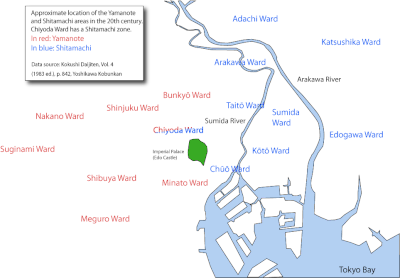
Yamanote (山の手) and Shitamachi (下町) are traditional names for two areas of Tokyo, Japan. Yamanote refers to the affluent, upper-class areas of Tokyo west of the Imperial Palace.[1][2] While citizens once considered it as consisting of Hongo, Kōjimachi, Koishikawa, Ushigome, Yotsuya, Akasaka, Aoyama and Azabu in the Bunkyō, Chiyoda, Shinjuku, and Minato wards,[1] in popular conception, the area extended westwards to include the Nakano, Suginami, and Meguro wards after the Great Kanto Earthquake in 1923.[1] Shitamachi is the traditional name for the area of Tokyo including today the Adachi, Arakawa, Chiyoda (in part), Chūō, Edogawa, Katsushika, Kōtō, Sumida, and Taitō wards, the physically low part of the city along and east of the Sumida River, mostly consisted of commercial areas and chonin residential areas during the Edo period.[2][3]
The two regions have always been vaguely defined, as their identity was more based on culture and caste than on geography.[4] While Tokugawa vassals of the samurai caste (hatamoto and gokenin) lived in the hilly Yamanote, lower castes (merchants and artisans) lived in the marshy areas near the sea. This dual class and geographic division has remained strong through the centuries while evolving with the times and is still in common use today.[5] Indeed, the two terms are now used also in other parts of the country. The term Yamanote still indicates a higher social status, and Shitamachi a lower one, even though de facto this is not always true.[5]
Both the Yamanote and the Shitamachi have grown gradually over the years, and the map above shows them as they are today.[6]
- ^ a b c Kokushi Daijiten Iinkai. Kokushi Daijiten (in Japanese). Vol. 14 (1983 ed.). p. 216.
- ^ a b Iwanami Kōjien (広辞苑) Japanese dictionary, 6th Edition (2008), DVD version
- ^ Kokushi Daijiten Iinkai. Kokushi Daijiten (in Japanese). Vol. 4 (1983 ed.). p. 842.
- ^ Cite error: The named reference
seidenwas invoked but never defined (see the help page). - ^ a b Edogaku Jiten, Kōbunsha, 1984, pages 14, 15, and 16.
- ^ Kokushi Daijiten Iinkai. Kokushi Daijiten (in Japanese). Vol. 4 and 14, pages 842 and 216 (1983 ed.).